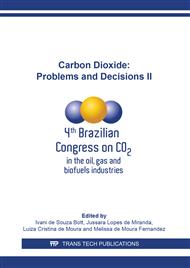p.59
p.69
p.79
p.87
p.97
p.107
p.117
p.125
p.133
Porosity and Permeability Alteration of Carbonates by CO2-Enriched Brine Injection
Abstract:
Some carbonate reservoirs are known for their high CO2 content in oil. One possibility to handle this gas without environmental problems is to reinject it into the reservoir. Injection of carbonated water has been drawing attention because it is an advantageous technique when compared to gaseous CO2 injection, due to its improvement in mobility in the reservoir. The objective of this study is to evaluate the phenomenon of dissolution and precipitation during carbonated water injection in carbonate rocks. These effects are identified by analyzing the porosity variations through X-ray computer tomography images and permeability profile, determined indirectly by pressure transducers that measured the differential pressure by the fluid at the inlet and outlet of the core holders. The Coreflooding test were carried out with two core holders in series to represent a near region at the reservoir by the injection of brine saturated with 25% of CO2 in reservoir samples, composed of dolomite, calcite and clay. The test were performed using the following reservoir conditions of 8,500 psi at 70°C. Based on the experimental data provided by CT images, it can be seen that the core porosity increases or decrease during carbonated water injection due to coexistence of dissolution (increase of porosity) and precipitation (decrease of porosity) along the samples. These phenomena are observed in regions with high heterogeneity in porosity. In addition, the mineralogy of the cores is composed by three minerals, which influence in the capacity of reaction with carbonated water. For the experiment, the core placed in the core holder one presented a porosity increase and the second one decreased. On the other hand, the permeability showed a significant increase for both cores, it is believed that, the injection promoted a preferential way flow (wormhole) that affected considerably the permeability of the rock. The novelty of the investigation is that the experiments were carried out using Brazilian pre-salt carbonate reservoir rocks with mineralogy composed basically by dolomite, calcite and clay. Also, experimental work was performed at reservoir operational conditions.
Info:
Periodical:
Pages:
107-115
Citation:
Online since:
July 2019
Price:
Сopyright:
© 2019 Trans Tech Publications Ltd. All Rights Reserved
Share:
Citation:


